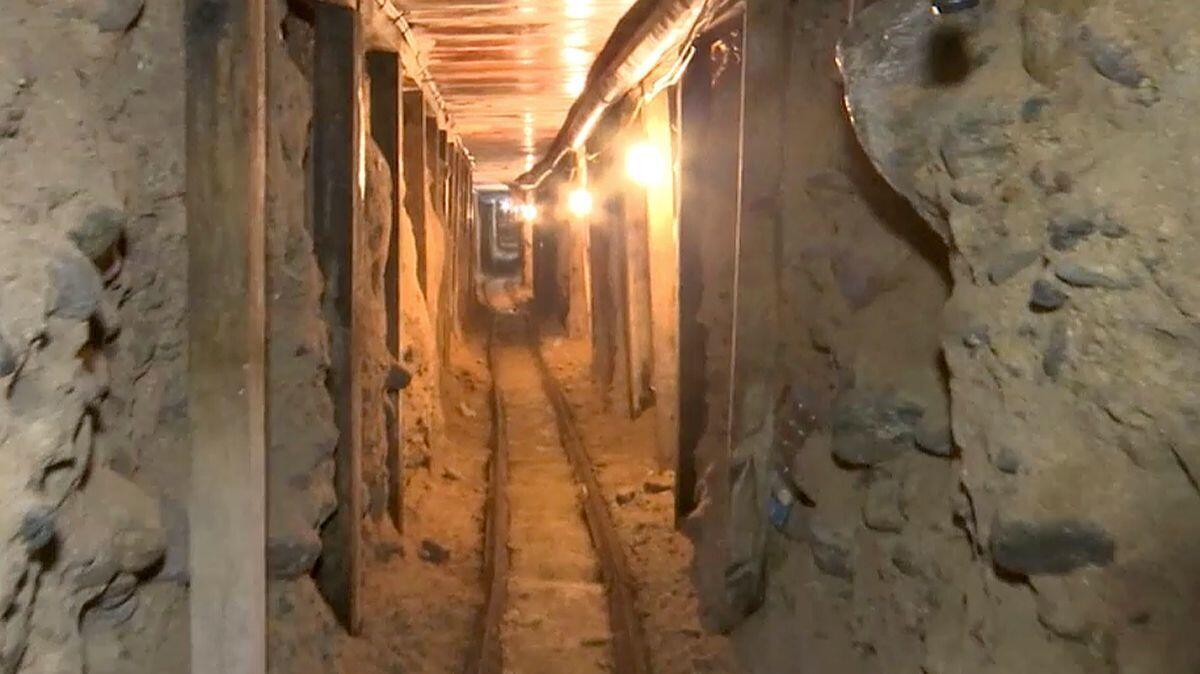Border tunnels left unfilled on Mexican side pose security risk, officials say

Reporting from San Diego — Mexican drug cartels have burrowed dozens of tunnels in the last decade, outfitted them with rail and cart systems to whisk drugs under the U.S. border and, after being discovered by authorities, abandoned them.
But some of the illicit passageways live on.
At least six previously discovered border tunnels have been reactivated by Mexican trafficking groups in recent years, exposing a recurring large-scale smuggling threat, according to U.S. and Mexican law enforcement officials.
The breaches of border defenses, most recently in December, occur because Mexican authorities, unlike those on the American side, do not fill the tunnels with concrete once they have been discovered. Mexican authorities say they lack the funds.
Instead, only the tunnel openings are sealed. That allows traffickers to simply dig a new entry point to access the largely intact subterranean passageways leading to the U.S. border.
The security lapse is a boon for traffickers, experts say, saving them time and money and reducing their risk of being caught as they haul away dirt.
“The biggest threat is that it’s a huge open invitation for drug traffickers, and it’s definitely going to be taken advantage of,” said Michael Unzueta, a former special agent in charge of Immigration and Customs Enforcement in San Diego.
The biggest threat is that it’s a huge open invitation for drug traffickers, and it’s definitely going to be taken advantage of.
— Michael Unzueta, former special agent in charge of ICE in San Diego
On the U.S. side, drug tunnels have been filled since 2007, after The Times reported that they were being left unfilled because of budget constraints at U.S. Customs and Border Protection.
Prompted by Sen. Dianne Feinstein (D-Calif.), who called the tunnels a “national security risk,” the agency has filled every large tunnel up to the border ever since, according to Department of Homeland Security officials.
U.S. authorities at the time anticipated that traffickers would reactivate the tunnels, and some recommended that the U.S. consider paying Mexico’s costs of filling the tunnels on its side. But funding sources were never found.
Since 2007, it has cost Customs and Border Protection $8.7 million to fill drug tunnels, according to a 2016 report by the Department of Homeland Security.
Now an estimated 20 large tunnels, constructed before and after 2007, remain largely intact on the Mexican side, according to U.S. and Mexican officials.
The tunnel issue could take on more urgency under the incoming administration of President-elect Donald Trump, who has made border security a central feature of his campaign. Border patrol agents who are part of Trump’s transition team said they plan to bring it up with the new administration.
“We don’t want to leave infrastructure in place in the form of half-completed tunnels for [cartels] to use,” said Shawn Moran, vice president of the National Border Patrol Council, the union of agents whose leaders have advised Trump on border security issues. “The cartels are by no means stupid. They’re taking the idea to work smarter, not harder, when it comes to these tunnels.”
When border fencing went up, traffickers moved underground. Since 2006 there have been 148 tunnels built, according to the DHS, most of them in Arizona and California.
The biggest underground threats now come from what border officials refer to as “super tunnels,” which cost millions of dollars to dig and feature sophisticated touches like lighting and ventilation systems that extend for hundreds of yards down wood-beamed passageways.
Most have been constructed in San Diego’s Otay Mesa region, 20 miles south of downtown.
The truck-clogged landscape of nondescript warehouses has long served as ideal cover for underground incursions emanating from a light industrial area directly across the border in Tijuana.
It was here in November 2010 that U.S. and Mexican authorities made one of the biggest drug busts ever, seizing 30 tons of marijuana from warehouses linked by a 600-yard passageway.
At a news conference in front the warehouse in San Diego, authorities dubbed it the “election day tunnel,” allowed reporters into the depths and declared a victory against traffickers.
“Frustrated by our defenses, they’re literally going underground, but we’re thwarting them there as well,” said John Morton, then director of U.S. Immigration and Customs Enforcement.
Afterward, mixing trucks on the San Diego side poured enough concrete to fill the tunnel all the way to the border two blocks away. On the Mexican side, workers poured concrete into the tunnel opening and declared it closed.
Four years later, in April 2014, U.S. and Mexican authorities were back in the same area. Traffickers had dug 700 yards from a window repair shop in Tijuana to another warehouse in San Diego.
When U.S. agents toured the tunnel they noticed that one segment was lined with older-looking electrical wiring and wooden support beams. It also had two sets of ventilation and cart tracks.
The election day tunnel, they determined, had been reactivated — about 1,025 feet of it.
According to coordinates provided by Homeland Security Investigations, a branch of ICE, traffickers appeared to have started digging the tunnel at the window repair shop, then burrowed across Jose Maria Velasco and Jose Lopez Portillo streets, where they tapped into the existing passageway.
From there, they had a free run to the border, and were able to reuse the electrical wiring and support beams.
“It saves them time and money because they don’t have to dig as far. It’s already there,” said Joe Dimeglio, a supervisory special agent with ICE Homeland Security Investigations. In recent years, traffickers have reactivated or tried to reactivate at least four other tunnels in the Otay Mesa area, most recently last month near Tijuana’s international airport.
Two more tunnels have seen resumed activity under the Mexicali-Calexico border, 100 miles east of San Diego, according to Homeland Security Investigations.
The election day tunnel remains largely intact in Mexico, concealed inside a high-walled compound where a security guard spends his time watching television on a torn-up sofa. The guard, Victor Mendiola, 55, is there because the property remains under the control of Mexican federal authorities.
Mendiola said his responsibility includes preventing people from accessing the concrete-sealed opening, which now has added layers of garbage and dirt.
But his presence, he admits, isn’t much of a deterrent. Clustered around the building on all sides are car repair shops, warehouses and homes, any one of which can serve as a staging ground for diggers wanting to tap into the tunnel beneath his feet.
“I’m here every day, but they could do it again,” Mendiola said. “It’s possible.”
Twitter: @richmarosi
To read the article in Spanish, click here
ALSO
UC protests shut down Milo Yiannopoulos talk, sparking free speech debate
Kevin Starr, author of California histories and former state librarian, dies at 76
More to Read
Sign up for Essential California
The most important California stories and recommendations in your inbox every morning.
You may occasionally receive promotional content from the Los Angeles Times.











